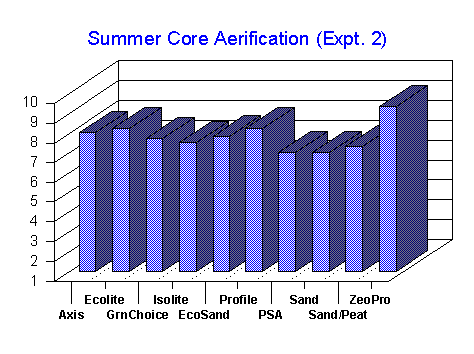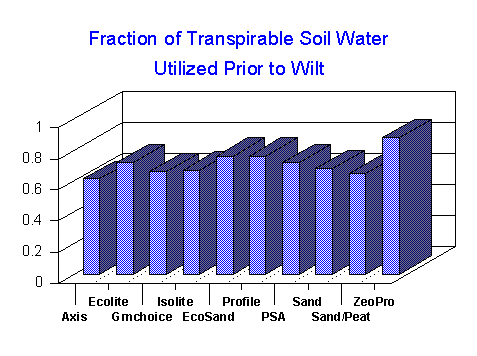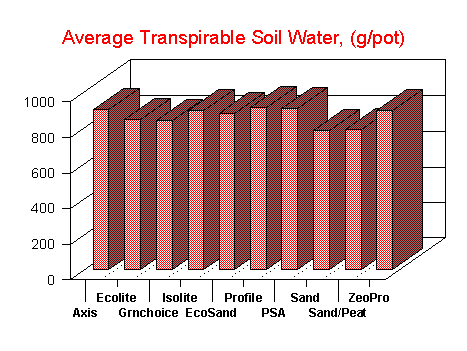Turfgrass Topdressing - Drought Stress
University of Florida
(HortScience 35(2):213-216.2000 G.L. Miller)
Turfgrass research was conducted by Professor Grady Miller, University of Florida, during 1997-98. The following summary has been prepared by ZeoponiX, Inc.
Dr. Miller states, "Six weeks after core aerification, best turf quality for both experiments was observed in ZeoPro amendment treatments." See charts below for comparisons among treatments.
"Modern golf greens are constructed using root-zone media consisting primarily of medium to course sand (0.25- 1.00 mm). The highly permeable sands resist compaction and have adequate aeration, infiltration and percolation, but poor nutrient and water retention. During construction and maintenance, golf green soils are often amended to improve resiliency and nutrient and water retention (beard, 1973). Decomposed peat is the organic material most commonly used in root-zone modification. Although organic amendments increase water and nutrient retention, they decompose with time. Thus, an amendment is needed that will increase water and nutrient holding capacity while remaining stable over time...The purpose of this research was to examine the effects of several soil amendments currently marketed for golf green use on transpiration of 'Tifdwarf' Bermudagrass during drought stress and their influence on drought stress avoidance."


Two experiments were conducted, experiment one in the spring and experiment two in the summer. Soil amendments studied were Axis, Ecolite, EcoSand, Greenschoice, Isolite, native soil, Profile, PSA, Sand, Sand + peat, and ZeoPro. In both experiments grass was established over a 6 week period in greenhouse pots by sprigging. The amendments were applied via core aerification, resulting in the amendment comprising 11% of the surface area and 8.5% of the total volume of the root zone. Following core fill treatments the pots were grown for another 6 weeks. Turf quality was evaluated 6 weeks after amendment additions using a 1 to 10 (best) turf rating scale. At twelve weeks after sprigging, water was withheld in the drought stress experiment to allow soil dehydration and to observe grass response.
Transpirable Soil Water: In both experiments, spring and summer, turfgrass grown in ZeoPro closed its stomata at a much smaller fraction of transpirable soil water (FTSW) point than did the turfgrass in the other amendments. Dr. Miller states, "The lower FTSW for stomatal closure means that the plant could extract additional soil water before stomatal closure and thus would exhibit a comparatively higher transpiration rate for a longer period of time. This delayed closure of stomata would appear to be advantageous under drought conditions when stress is short and intermittent." (See chart below, plot of FTSW vs. various amendment treatments. Note that ZeoPro has the highest utilization of transpirable soil water before wilt.)

Dr. Miller continues, "This study demonstrates that turfgrass may perform differently when grown in various inorganic root-zone media. These data suggest that inorganic soil amendments can influence soul water content, which may ultimately influence the plant's response to drought stress...(see chart below). Even in the small volumes tested in this study, several amendments enhanced tuf quality and improved moisture status in comparison with sand." While all amendments tested showed improved transpirable soil water (TSW) compared to sand or sand:peat, ZeoPro exhibited a higher total utilization of available TSW prior to the onset of turf wilt than any other amendment.

Copyright 2000 ZeoponiX, Inc. P.O. Box 19105, Boulder, CO 80308 USA
(303) 673-0098 Fax (303) 673-9583 E-Mail: zeoponix@zeoponix.com